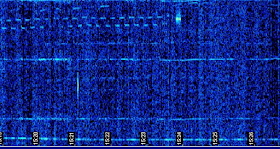I was feeling kind of bad about the fact that while free shipping for the book is available for readers in the U.S., people from other countries are not eligible. But Lulu came through! During May readers everywhere can get 10 percent off by using the coupon code FLOWERS. Lulu won't let you combine free shipping AND the 10 percent off; U.S. customers are probably better off sticking with the free shipping. Customers from other countries can use the 10% discount during May.
Steve, KC2VNI, sent in some nice comments on the book:
---------------------------
I am an electrical engineer and I will say that the way Bill explains things is far, far, better than what I've seen in most books dealing with either communications theory or with communications electronics.
Not to go on a rant, but the college level electrical engineering text books are very poorly thought out and are really not written for the beginner (even an undergraduate electrical engineering student) who does not share the author's years of insight.
I would recommend that people who read the book should post comments about it where hams will find it. I posted comments on E-Ham. I will probably post to Ham Radio nation.
Several tweaks to the book (with the understanding that my comments are NOT meant as a slam on the book nor am I an electronics expert):
1) Give me a more detailed troubleshooting methodology- The literature associated with testing and troubleshooting is very,very limited.
A flow chart or diagram of some sort would be very helpful. I get the impression that Bill's efforts in this area were "cut and try" because of his obvious enthusiasm. Having said this, the beginning home-brewer has NO IDEA as to what he needs in the way of test equipment, what he should look for when testing a circuit, what the wave forms should look like, etc. (Note from Bill: A detailed discussion on troubleshooting methodology would be very helpful to students taking
electrical engineering online.)
2)Very little discussions about the more mundane things like power supplies, connectors and the like. These trivial items can cause you hours of frustration if you don't think this through. If you want to string things together on a bench, I suppose it does not make difference. However, if you want to operate say QRP mobile in the woods then you need something that has a little bit of thought.
3) Very little discussion about heat sinks and thermal management- This is one of the most neglected areas for most people in electronics (and not just the homebrewer of radio equipment). Here, I recommend the ASME text "Hot Air Rises and Heat Sinks: Everything You Know About Cooling Electronics is Wrong". When I read the discussion about a transistor running hot and extra heat sink compound being applied in the book, I wanted to scream!
One other thing-is there any way I can get an autographed copy of the text?
Thank You very much for this very fun book
73
Steve KC2VNI
 A few years back Ian Keyser, G3ROO, put together a really wonderful antenna book. It is very "down to earth," very practical, very useful for hams seeking to succeed with homebrew antennas. The book was edited by another great person from G-QRP Club -- Tony Fishpool, G4WIF. It has been out of print, but Ian has just made it available through Lulu.com.
A few years back Ian Keyser, G3ROO, put together a really wonderful antenna book. It is very "down to earth," very practical, very useful for hams seeking to succeed with homebrew antennas. The book was edited by another great person from G-QRP Club -- Tony Fishpool, G4WIF. It has been out of print, but Ian has just made it available through Lulu.com.






















